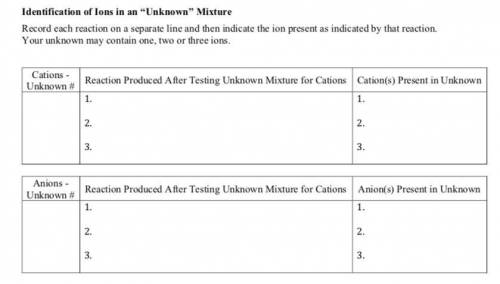
Chemistry, 30.06.2020 07:01 rodriguezg16
cation number 5: white precipitate and a milky suspension cations: Ag^+, Ca^2+, and Fe^3+ Anions 17: bubbles and color change from dark pink/purple to colorless anions: (CO3)^2-, (C2O4)2-, and (SO4)2- idk if this is needed but Test for Ag+ 1. 2 mL of HCl was added to the beaker containing the mixture and swirled gently to mix thoroughly. Ag+ combines with Cl- to form a white precipitate (AgCl) The equation for this reaction is: Ag+(aq) + Cl-(aq) → AgCl(s) 2. A funnel with filter paper was placed in a 125mL Erlenmeyer flask. The mixture was poured into the filtration apparatus to remove the precipitate. The filtrate (liquid remaining in the Erlenmeyer after being filtered) was saved for the analysis of Fe3+. The filter paper containing AgCl precipitate was properly disposed of in the appropriate waste container. Test for Fe3+ 3. A small piece of litmus paper was added to the Erlenmeyer flask containing the filtrate. Excess ammonium hydroxide was then added to the mixture in the flask until the litmus paper turned blue. The mixture was swirled gently to thoroughly mix the contents of the flask. (Picture shown is in a beaker, not an Erlenmeyer, but the reaction is correct.) Fe3+ combines with OH- to form a red/brown precipitate Fe(OH)3 The equation for this reaction is: Fe3+(aq) + 3 OH-(aq) → Fe(OH)3(s) 4. The mixture was filtered into another Erlenmeyer flask to remove the precipitate. The filtrate in the flask was saved for the analysis of Ca2+. The filter paper containing Fe(OH)3 precipitate was disposed of in the appropriate waste container. Test for Ca2+ 5. To test for Ca2+, a test tube was filled halfway with the filtrate from Step 4. One eye-dropper of ammonium oxalate solution [(NH4)2C2O4)] was added to that test tube. Ca2+ combines with C2O42- ions to forms a white suspension (CaC2O4) The equation for this reaction is: Ca2+(aq) + C2O42- (aq) → CaC2O4(s) 6. This was the final step in the analysis, so there was no need to filter the precipitate. The entire contents of the remaining mixture can be disposed in the calcium oxalate waste container. Part 2: Identification of Anions: This qualitative analysis of anions is very similar to the identification of cations. The primary difference between cation analysis and anion analysis is in the separation steps; with cations, separation is common, but with anions, separation is rare. In the anion analysis the sequence of the reactions is very important. In this experiment you will study the reactions of three anions (CO32-, C2O42-, SO42-), then identify the presence of one of more of these anions in an “unknown” mixture. Reagents for anion analysis: • Barium chloride, BaCl2: highly toxic by ingestion and inhalation. • Nitric acid, HNO3: highly corrosive; causes severe burns on eye and skin contact. • Potassium Permanganate, KMnO4: causes severe eye and skin irritation with possible burns. Harmful if swallowed • Sodium carbonate, Na2CO3: possible skin irritant. • Sodium oxalate, Na2C2O4 : moderately toxic by ingestion and inhalation. Corrosive to body tissues. • Sodium sulfate, Na2SO4: body tissue irritant. (dilute solution not considered hazardous) Test for CO32- 1. 2 droppers (approximately 2 mL) of nitric acid (HNO3) was added to the beaker containing the mixture and swirled to mix thoroughly. Evolving bubbles indicate the presence of the carbonate ion, CO32-. The overall equation (which is also called the “net ionic equation”) for this reaction is: 2 H+(aq) + CO32-(aq) → CO2(g) + H2O(l) 2. HNO3 was added drop wise until the formation of bubbles stops. 1 additional dropper of HNO3 was added and mixed thoroughly. Test for C2O42- 3. One drop of potassium permanganate (KMnO4 which is a deep purple color) solution was added to the beaker containing the mixture from Step 2 above and allowed to react for 3-5 minutes. The disappearing of pink color indicates the presence of oxalate ion, C2O42-. The formation of bubbles of CO2 might also be observed. The overall net ionic equation for this reaction is: 2 MnO4-(aq) + 5 C2O4-(aq) + 6 H+(aq) → 10 CO2(g) + 2 Mn2+(aq) + 8 H2O(l) Test for SO42- 4. One eye-dropper of barium chloride (BaCl2) solution was added to the beaker containing the mixture from Step 3 above. One additional eye-dropper of BaCl2 solution was added and mixed well. The formation of a pale white suspension indicates the presence of the sulfate ion. Two barium ions, Ba2+, combine with a sulfate ion SO42- to form a pale white precipitate of barium sulfate (BaSO4). The net equation for this reaction is: 2 Ba2+(aq) + SO42-(aq) → BaSO4(s)


Answers: 3


Another question on Chemistry


Chemistry, 22.06.2019 02:00
Which of the following happens during cell division? (a) energy is created (b) waste is eliminated (c) carbon dioxide is released (d) damaged cells are replaced
Answers: 1

Chemistry, 22.06.2019 08:00
Joe shines white light into a bowl half full of water at an angle of incident of 27.5°. calculate the angle of refraction in the water given the indices of refraction for air and water are 1.00 and 1.36, respectively.
Answers: 2

Chemistry, 22.06.2019 10:10
How do you identify the anode on a power source such as a battery? how do you identify the cathode? how are terms anion and cation?
Answers: 1
You know the right answer?
cation number 5: white precipitate and a milky suspension cations: Ag^+, Ca^2+, and Fe^3+ Anions 17:...
Questions


Health, 30.08.2021 18:30

Social Studies, 30.08.2021 18:30


Mathematics, 30.08.2021 18:30



Mathematics, 30.08.2021 18:30



Social Studies, 30.08.2021 18:30

Mathematics, 30.08.2021 18:30

Mathematics, 30.08.2021 18:30


Physics, 30.08.2021 18:30


Arts, 30.08.2021 18:30



English, 30.08.2021 18:30



